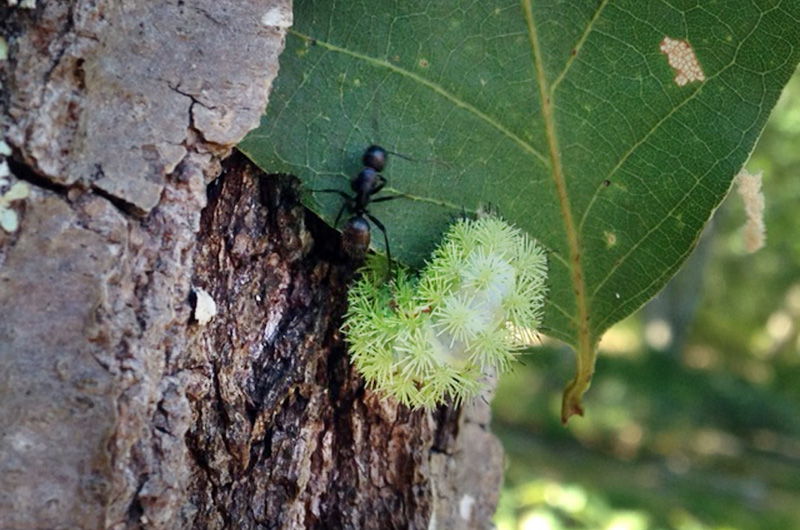The caterpillar in Lewis Carroll’s Alice in Wonderland had this recommendation: “Keep your temper.” Good advice for a Vineyard summer. Thankfully, September is here, a favorite month for many of us. Numbers of many things are down. There are fewer people, fewer cars, lower temperatures, and, for some, a reduction in the hours we work.
There is something, however, that increases dramatically this month. Caterpillars, whether advice-giving or not, are everywhere. In the last week, I have easily seen more than a dozen different species of these crawling creatures, and am fascinated by the diversity and uniqueness of each and every one.
These crawlers come in many shapes and sizes, from the smallest caterpillar that just emerged from an egg to the giant hornworm that can reach three inches or more. Some caterpillars have that expected elongated cigar shape, while others can be round, square, and even have odd protrusions, bristles, hairs, bumps and appendages.
All of these oddities are useful for protection and defense. Caterpillars are a protein-packed food source for birds, mice, frogs, insects, and lizards. However, caterpillars won’t go down (the gullet) without a fight.
Their fighting ways are more passive than active. Consider those bristles, spines and hairs. These structures may have uticating hairs that can cause irritation and rashes, especially for those with sensitive skin. One South American species has venom so toxic, which acts as an anticoagulant, and is strong enough to cause a human to bleed to death.
It is no surprise then, that people (especially children) are often advised not to touch hairy caterpillars. Common hairy and bristly caterpillars seen here on the Island include tussock moth caterpillars, puss caterpillars (most venomous caterpillar in the U.S.), woolly bear caterpillars, leopard moth caterpillars, and io moth caterpillars.
Horns and posture are other methods of protection that may dissuade a hungry predator, as does coloring. Aposematism is the use of colors or patterns to warn predators of an organ ism’s toxicity or distastefulness. Cryptic coloring allows a caterpillar to blend into its environment — think of a green caterpillar on a green leaf. Mimicry is another technique. There are caterpillars that look exactly like a twig. Others, like monarch caterpillars, use bright colors that are easily recognizable to predators who have learned that caterpillars bearing these colors are toxic or distasteful.
The presence of these autumn caterpillars is fleeting. Caterpillars are a life stage of all Lepidoptera, an order of insects that includes butterflies and moths. Once the cold comes, they will have metamorphosed or will wait out winter in their own self-made enclosure.
Theirs is a complete metamorphosis, a four-stage process that includes egg, larva, pupa and adult. The pupa stage of moths is a silk-covered cocoon, while a butterfly has a smooth, hard chrysalis.
Caterpillars are not just food for others; they are also voracious eaters themselves. Besides avoiding predators, eating is their most important job. Their first meal is their own eggshell. Caterpillars go through growth stages, or instars, often up to five times, increasing their body size by 1,000 times or more.
As an example, monarchs gorge on 200 times their birth weight in milkweed leaves (175-200 leaves each) in only 10 to 14 days. That is comparable to a seven-pound newborn child consuming 1,400 pounds of milk or formula in a two-week period. That would make a human mother shudder.
Most caterpillars are herbivorous, eating plants and lots of them, though one per cent is carnivorous, mostly eating insects. Malnourished caterpillars won’t thrive and may not be able to metamorphose.
Caterpillars are also known for their damage of gardens, agricultural landscapes and natural habitats. And don’t get me started on their frass (droppings), which is often the first indication of their presence.
While it is easy to malign caterpillars, they are an important life stage, even if all they appear to do is eat and grow. For them, the ends justifies the means: as comedian George Carlin observed, “The caterpillar does all the work but the butterfly (or the moth) gets all the publicity.”
Suzan Bellincampi is director of the Felix Neck Wildlife Sanctuary in Edgartown, and author of Martha’s Vineyard: A Field Guide to Island Nature.







Comments
Comment policy »